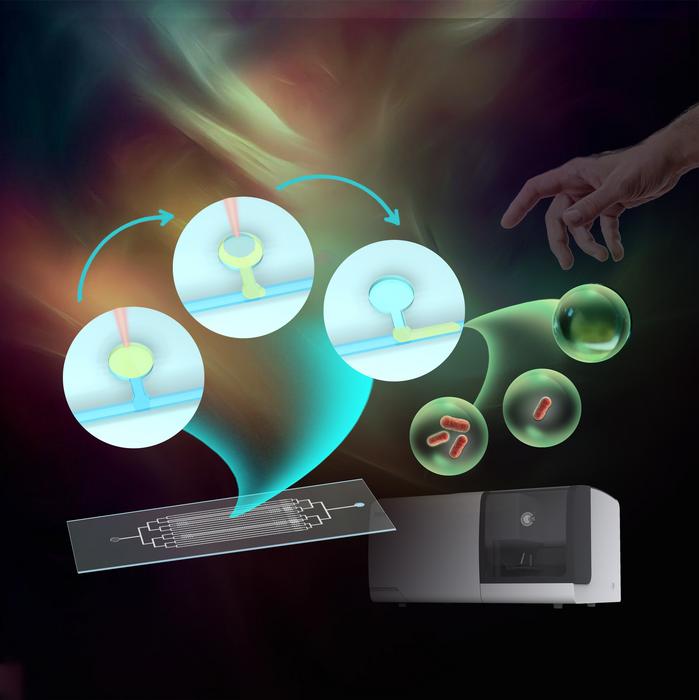Static droplet array (SDA) is a necessary and integral tool when it comes to high-capacity screening tests, or assays, for identifying and targeting specific cells or analytes (substances whose chemical composition is the target of identification). However, extraction and collection of the target droplets that contain unique analytes or cells from the SDA remains one major technical bottleneck that limits its broader application.

Credit: LIU Yang
Static droplet array (SDA) is a necessary and integral tool when it comes to high-capacity screening tests, or assays, for identifying and targeting specific cells or analytes (substances whose chemical composition is the target of identification). However, extraction and collection of the target droplets that contain unique analytes or cells from the SDA remains one major technical bottleneck that limits its broader application.
By incorporating laser technology and an indium tin oxide (ITO) layer into a droplet microfluidics chip, researchers from Single-Cell Center in the Qingdao Institute of Bioenergy and Bioprocess Technology (QIBEBT) of the Chinese Academy of Sciences (CAS) and their collaborators have developed a new system, optical on-demand droplet release (OODR). The OODR system allows for a more user-friendly method to be used in screening assays that also reduces the amount of the sample and reagents needed without compromising efficiency, cell viability or analysis accuracy.
Their findings were published in Biosensors and Bioelectrics on Aug. 25.
“OODR works by precisely heating the ITO layer with laser to create microbubbles that allow for the selective pushing of a target droplet out of the chamber on the microfluidics chip based on the microdroplet single-cell sorting system, such as EasySort Compact,” said Dr. DIAO Zhidian, first author of the study. E. coli and yeast cells were successfully used, suggesting the OODR system has a wide range of applicability to other cells.
The size of the microbubble proved to be critical when it came to successful release of the droplet based on the chip design used by the researchers. By honing in the right size of the microbubble (40 μm) and getting the laser intensity in the correct range to create the heat needed to form the bubble but not degrade the cell’s integrity, the desired results were achieved, and the droplet was released within just three seconds under appropriate conditions.
The droplet, identified by using white or fluorescent imaging, is then conveniently “packaged” and exported in a one-droplet-one-tube (ODOT) manner by capillary force, which allows for the movement of liquid without any external force applied, and into a well or tube in a high-throughput manner for further analysis. The images provided are helpful in sorting the morphology of the target bacteria, something that is difficult to do without a static image readily available.
Not only does OODR help out with the packaging and releasing of a target droplet in SDA, but it also doesn’t appear to affect the cell’s ability to be cultivated, which is essential when further live-cell analyses are needed. This, combined with the reduced amount of reagent needed and smaller sample size for analysis, means a more cost-efficient route than the other means available.
The success of the OODR system grants expansion and improvement upon the SDA tool by improving single-cell analysis in addition to making the technique more efficient and more cost-effective.
“Our ultimate goal is to build an automated and efficient OODR system for expanding the application of SDA in various fields,” said Dr. WANG Xixian, co-first author of the study.
“We have successfully used the EasySort Compact for automatic single-cell sorting,” said the corresponding author, Prof. MA Bo from the Single-Cell Center. “This newly developed OODR system has advanced the sorting capability from single-cell to single-microdroplet level. It not only targets single-cells but also enables soring of microdroplets that contain one cell, multiple cells, or even just reagents.”
At present, they are utilizing AI and machine learning to create an automated system via the EasySort instrument, to trim as much human involvement as possible, said another corresponding author, Prof. XU Jian, the head of Single-Cell Center. The automation would ideally also make it easier for non-professionals to use, further expanding the application of the OODR technology.
Journal
Biosensors and Bioelectronics
DOI
10.1016/j.bios.2023.115639
Article Title
Optical-based microbubble for on-demand droplet release from static droplet array (SDA) for dispensing one droplet into one tube
Article Publication Date
25-Aug-2023




